El Teatro de marionetas acuáticas Thang Long ofrece una experiencia cultural fascinante y única que permite a los visitantes sumergirse en las ricas tradiciones de Vietnam. Esta antigua forma de arte, que data del siglo XI, muestra la creatividad y el ingenio de los titiriteros vietnamitas. Los espectáculos de marionetas acuáticas del Teatro Thang Long ofrecen una ventana a la cultura local y cautivan tanto al público joven como al adulto.
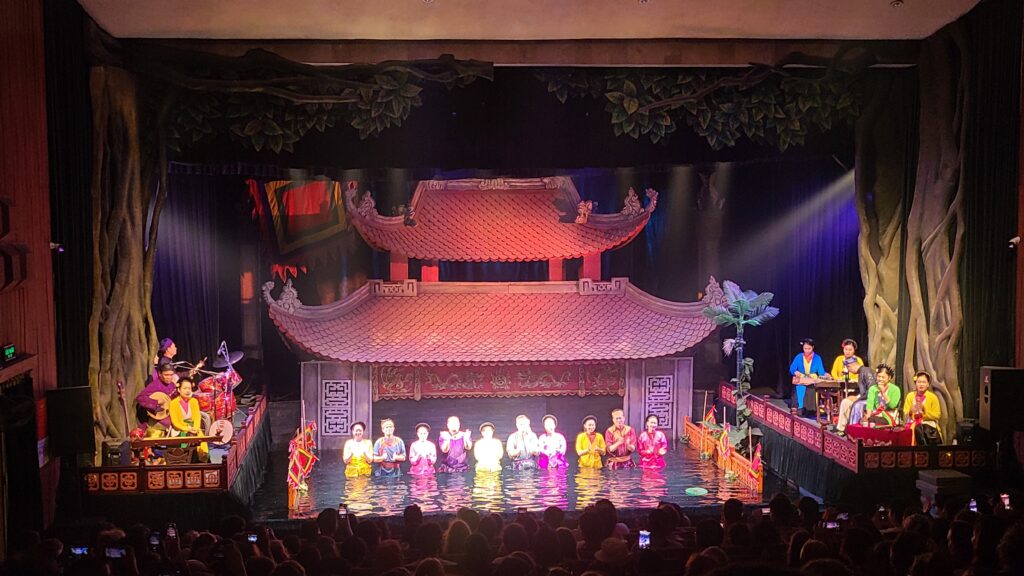
Una breve historia de los títeres acuáticos
El teatro de marionetas acuáticas tiene su origen en los pueblos de la región del delta del río Rojo, en el norte de Vietnam. Inicialmente, se representaba durante los festivales anuales de la cosecha de arroz, donde los agricultores se reunían para celebrar y entretenerse mutuamente. Los espectáculos se realizaban en campos de arroz inundados, lo que creaba un escenario submarino único para las marionetas.
Con el tiempo, las marionetas acuáticas pasaron de ser una forma de arte popular a convertirse en un espectáculo del que disfrutaba la realeza. Durante el siglo XII, bajo el reinado de la dinastía Lý, se seleccionaron las mejores compañías de marionetas acuáticas para entretener al rey y a sus invitados, lo que elevó el estatus social de este arte. Hoy en día, las marionetas acuáticas se reconocen como un preciado patrimonio cultural inmaterial de Vietnam.
El arte de las marionetas acuáticas
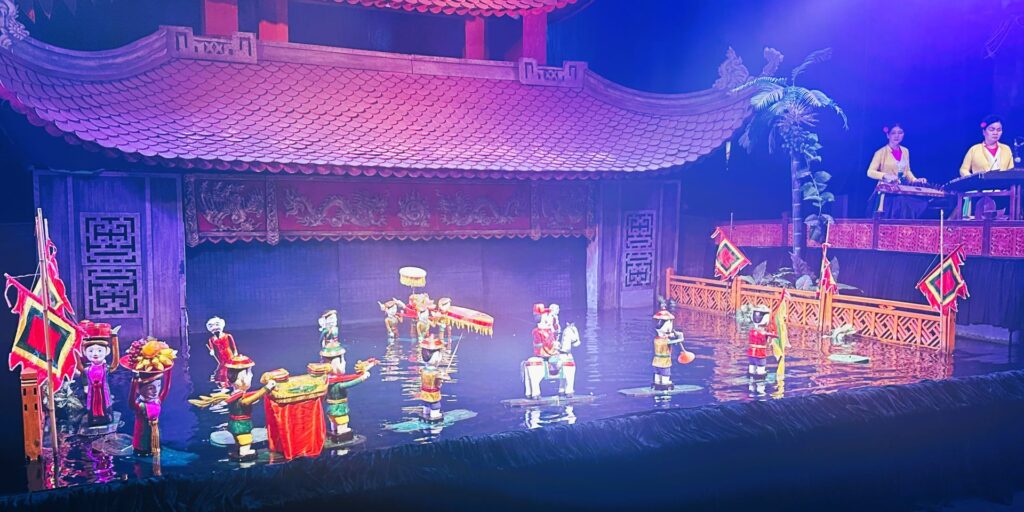
El arte de las marionetas acuáticas es un oficio que exige mucho esfuerzo físico y que requiere años de entrenamiento para dominar. Las marionetas, hechas de madera de higo flotante y lacadas para que duren más tiempo, son manipuladas hábilmente por titiriteros que permanecen de pie con el agua hasta la cintura durante toda la actuación. Los movimientos de las marionetas están sincronizados con la música y la narración, creando un espectáculo visual cautivador.
Los espectáculos están acompañados por una orquesta tradicional vietnamita, que proporciona la música de fondo para las actuaciones. Los cantantes de Cheo, un tipo de ópera originaria de Vietnam del Norte, cantan canciones que narran las historias que representan los títeres. La combinación de música, canto y títeres crea una experiencia multisensorial para el público.
Escenas y personajes
El teatro de marionetas acuáticas Thang Long muestra una variedad de escenas y personajes que representan la vida cotidiana en las aldeas del norte de Vietnam. Cada escena cuenta una historia, a menudo con un significado moral o cultural. Exploremos algunas de las escenas y personajes más emblemáticos que aparecen en los espectáculos de marionetas acuáticas:
1. Tễu – El presentador cómico
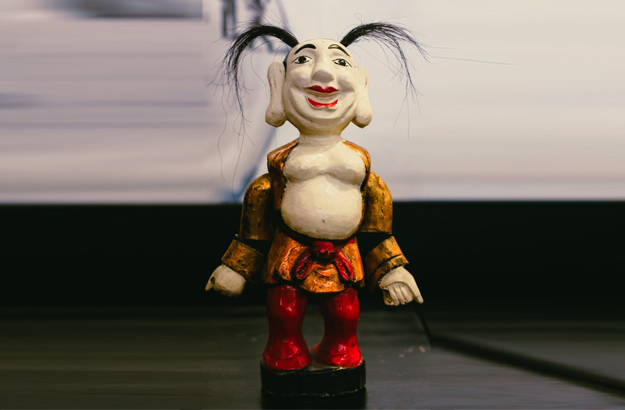
Uno de los personajes más destacados del teatro de marionetas acuáticas es Tễu, el presentador cómico. Tễu es un narrador extravagante que presenta al público diferentes escenas e historias a lo largo del espectáculo. Con sus ingeniosos comentarios y su actitud humorística, Tễu añade un toque de alegría a las actuaciones.
2. Danza del Dragón y Danza del Fénix
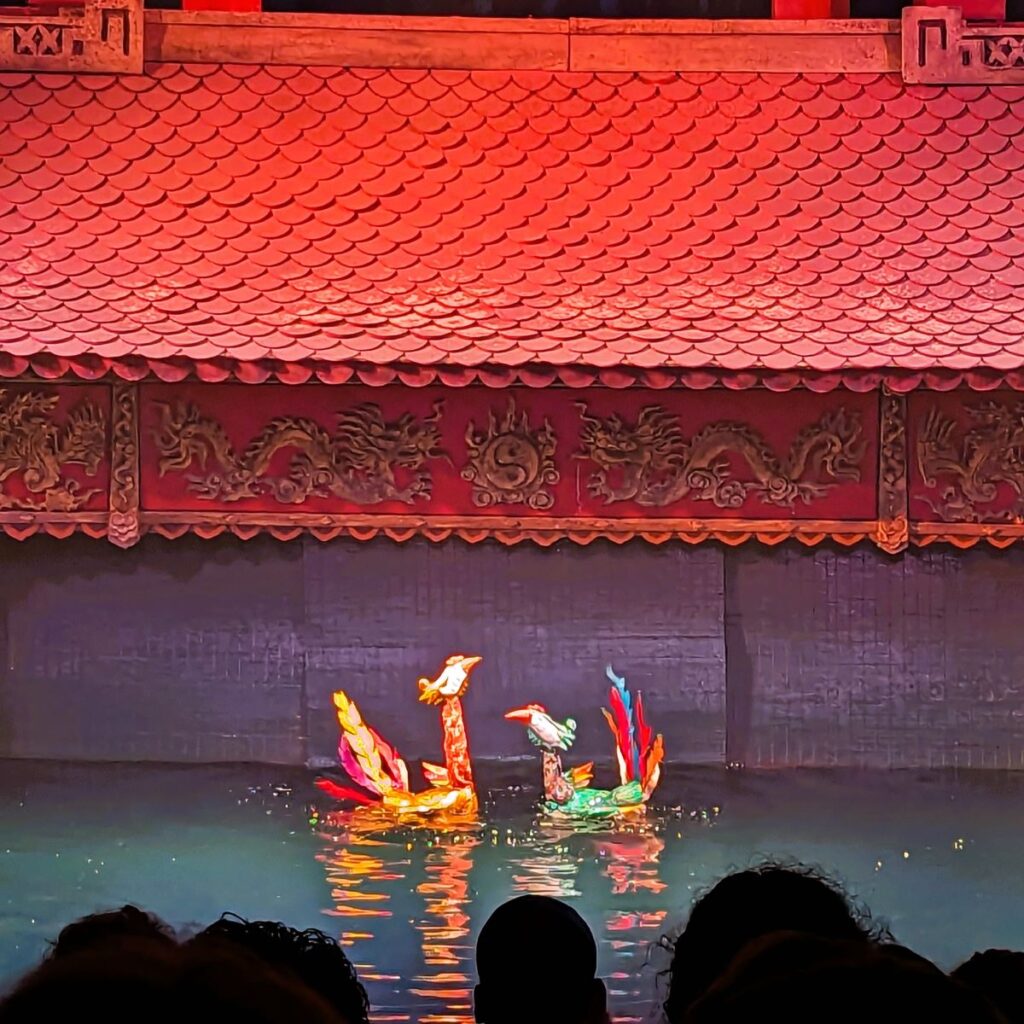
El dragón se considera un símbolo importante en la cultura popular vietnamita, ya que representa la fuerza y la prosperidad. La danza del dragón es una actuación dinámica y enérgica que muestra la agilidad y la coordinación de los titiriteros. En cambio, la danza del fénix simboliza la fidelidad en la vida matrimonial y suele ser interpretada por un par de títeres, un hombre y una mujer.
3. Agricultura y siembra de arroz
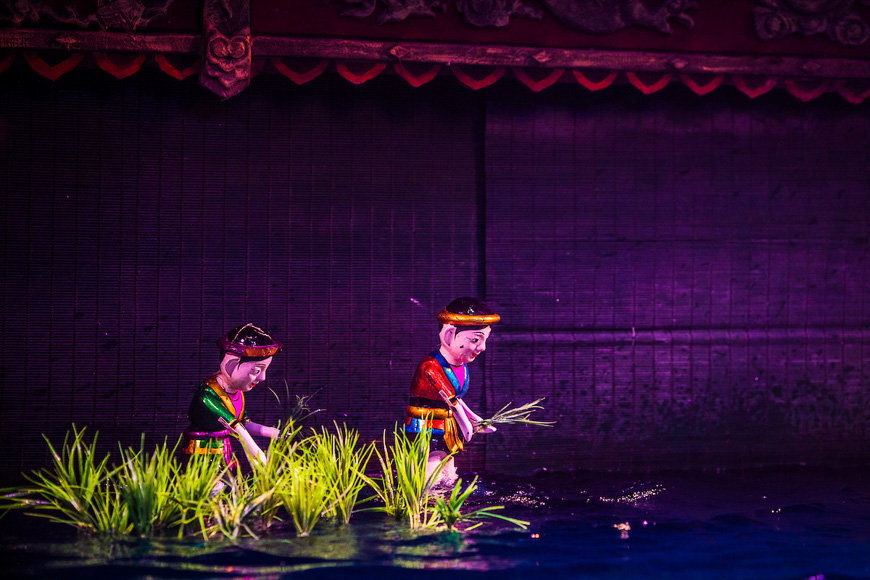
El patrimonio agrícola de Vietnam se representa de forma hermosa en los espectáculos de marionetas sobre el agua. Las escenas que representan el arado, el agua que se arroja a la tierra y la cosecha reflejan el trabajo duro y la dedicación de los agricultores vietnamitas. Las marionetas dan vida al espíritu del campo y resaltan la importancia del cultivo del arroz en la cultura vietnamita.
4. Pesca y pesca de ranas

La pesca no es solo un medio de vida, sino también una actividad de ocio para los agricultores vietnamitas. Los espectáculos de marionetas acuáticas presentan escenas de pescadores en pequeñas embarcaciones, lanzando sus redes y capturando peces. Además, la divertida historia de la pesca de ranas entretiene al público con su representación cómica de la excursión de pesca de un granjero.
5. Persiguiendo al zorro
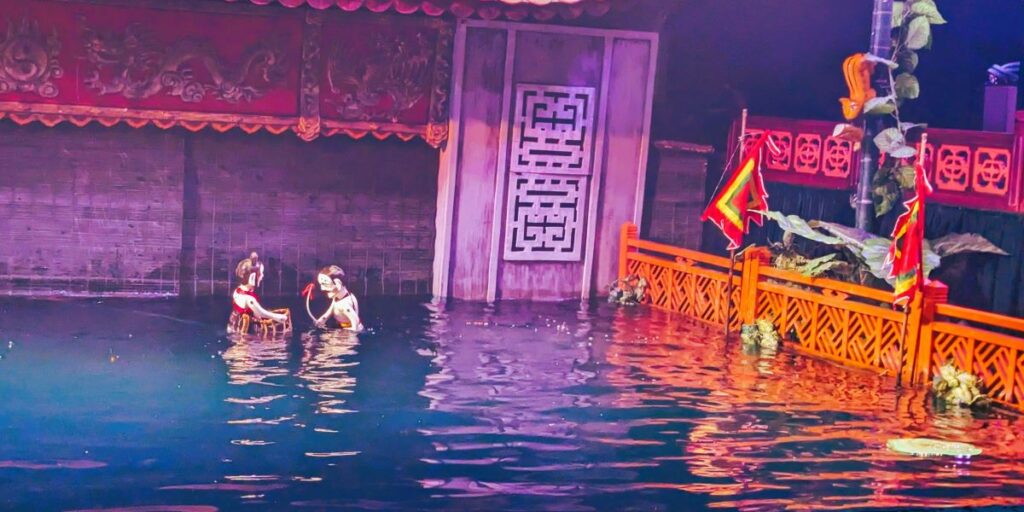
Esta escena cuenta la historia de una pareja de ancianos que debe proteger a sus patos de un astuto zorro. Los titiriteros dan vida a esta historia con gran habilidad, mostrando la determinación y el ingenio de la pareja para ahuyentar al zorro. Es una representación conmovedora y divertida de la vida rural en Vietnam.
6. Desfiles reales y paseos en barco
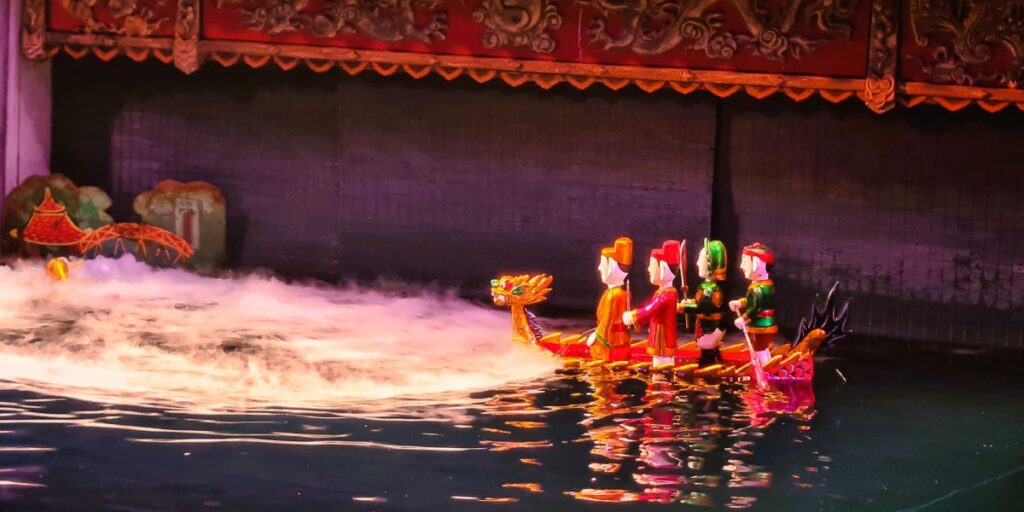
Los espectáculos de marionetas acuáticas también incluyen grandes desfiles reales, con marionetas vestidas con trajes elaborados y acompañadas por la música de la orquesta tradicional. Estas escenas ofrecen una visión de la pompa y el esplendor de la cultura real vietnamita. Las escenas de remo en botes muestran la habilidad y el trabajo en equipo necesarios para el transporte acuático tradicional vietnamita.
Dónde ver el teatro de marionetas acuáticas de Thang Long

Para apreciar plenamente el arte de las marionetas acuáticas, se recomienda visitar el Teatro de marionetas acuáticas Thang Long. Este famoso teatro, situado en Hanoi, ofrece espectáculos cautivadores que muestran lo mejor de las marionetas acuáticas vietnamitas. Los espectáculos se realizan en una piscina especialmente diseñada, que proporciona un impresionante telón de fondo para las actuaciones.
Para comprender mejor el arte de las marionetas acuáticas, es imprescindible visitar el pueblo de Đào Thục, en las afueras de Hanoi. Aquí podrá explorar uno de los últimos talleres de marionetas acuáticas que quedan en Vietnam y aprender sobre el intrincado proceso de fabricación de las marionetas. El pueblo también organiza espectáculos al aire libre que rinden homenaje a la tradición de 300 años de las marionetas acuáticas.
Si estás de visita en otras ciudades de Vietnam, hay varios teatros de marionetas acuáticas que vale la pena explorar. El Teatro de marionetas de Vietnam en Hanoi, el Teatro Hội An en Hội An, el Teatro de marionetas acuáticas de Huế en Huế y el Teatro de marionetas acuáticas Golden Dragon en Ciudad Ho Chi Minh ofrecen espectáculos excepcionales que resaltan la belleza y la importancia cultural de las marionetas acuáticas.
Conclusión
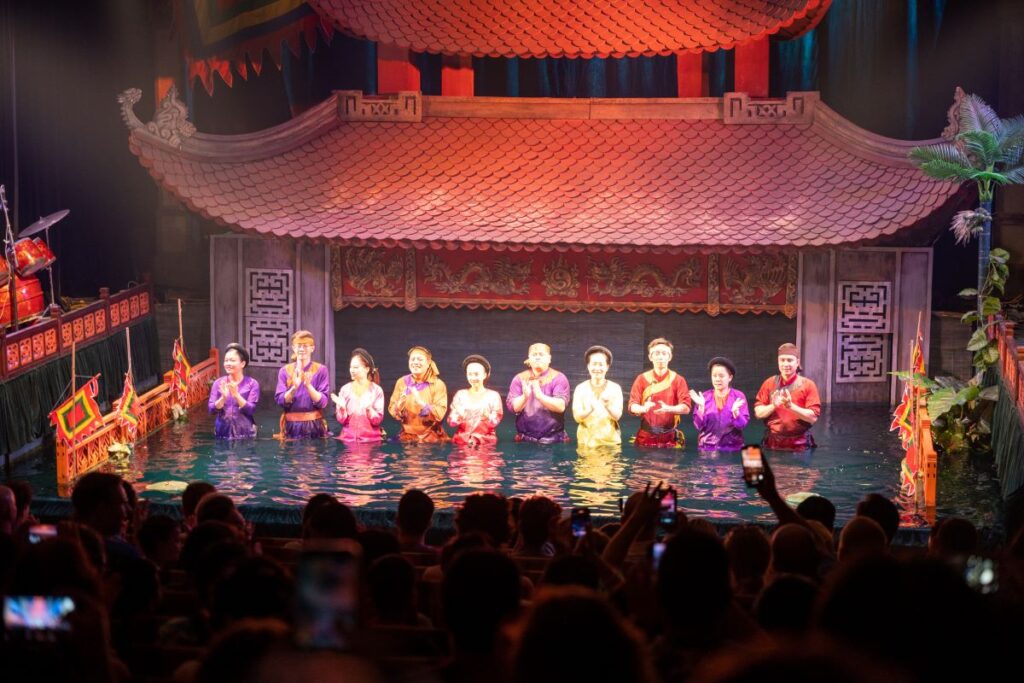
El Teatro de marionetas sobre agua de Thang Long es un destino obligado para quienes buscan una experiencia cultural única e inmersiva en Vietnam. Los espectáculos de marionetas sobre agua transportan al público a un mundo de tradición y folclore, mostrando la creatividad y la habilidad de los titiriteros vietnamitas. Desde escenas que representan la vida cotidiana de un pueblo hasta grandes desfiles reales, cada actuación en el Teatro de marionetas sobre agua de Thang Long es un testimonio del rico patrimonio cultural de Vietnam. No pierda la oportunidad de presenciar esta cautivadora forma de arte y crear recuerdos duraderos de su visita a Vietnam.

